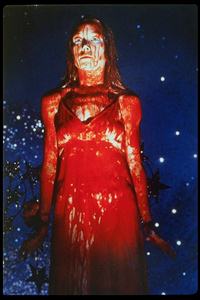

USA suspense
1976
color 98 min.
Director: Brian De Palma
CAV: out-of-print collectible
2 discs, catalog # CC1278L
CLV: out-of-print collectible
1 disc, catalog # CC1322L

In
1972, Stephen King began writing a short story entitled "Carrie". The opening
revolved around the unexpected and late arrival of Carrie White's first menstrual
period in front of her classmates in the girls' locker room. But, King stopped
when he realized that not knowing what it was like to have a menstrual period, it
was very difficult to define the character's reaction. The only time he had even
been in a girls' locker room was during a summer job as a janitor in a high
school in Maine. He crumpled the pages and threw them in the kitchen wastebasket.
About an hour later, Tabitha, his wife, to whom Carrie is dedicated,
fished them out and pressed him to continue to write the story. "Carrie" became a
novel, and several months later Doubleday bought it. Thus began Stephen King's
amazing career.Before the novel became available in bookstores, there was a
lot of film interest and the rights finally went to producer Paul Monash. Stephen
King was a fan of a horror film entitled Sisters, which Brian De Palma
directed in 1973, and he suggested De Palma for Carrie.
Carrie
was De Palma's tenth feature film and a major breakthrough in his career. His
first movie was The Wedding Party which was shot between 1964 and 1966. De
Palma then directed Murder ˆ la Mod (1968), Dionysus in '69 (1969),
Get to Know Your Rabbit (1970), Sisters (1973), Phantom of the
Paradise (1974) and Obsession (1976), among other works, prior to
Carrie.
Throughout his career, Brian De Palma has launched the careers
of many actors and actresses. Robert De Niro's first film, for instance, was
The Wedding Party. Carrie brought attention to Sissy Spacek, Amy
Irving, John Travolta, Nancy Allen, and Betty Buckley, and marked Piper Laurie's
comeback to the big screen. Sissy Spacek received an Academy Award nomination for
Carrie and won the Best Actress Award from the National Society of Film
Critics. Piper Laurie received an Academy Award nomination for Best Supporting
Actress, as well as a Golden Globe nomination in the same category.
With
Carrie, De Palma was confronted for the first time with the demand for
sophisticated mechanical effects. He called in Gregory M. Auer, who had already
worked with him on Phantom of the Paradise, to orchestrate the presentation of
Carrie's supernatural forces. The most challenging scene -- which turned
out to be one of the most spectacular moments in the film -- was the death of
Piper Laurie, a special effects tour de force.
Lawrence D. Cohen was hired to
adapt the novel. He would later write the script to Peter Straub's best-seller
Ghost Story, Stephen King's It, and adapt Carrie into a
musical for the stage.
Audience response turned this low-budget wonder into a
box office triumph, but Carrie was far more than a commercial success. Its
critical acclaim focused on the superb acting, and on the emergence of a
significant auteur. The variety of De Palma's visual elements confirmed that he
had a film language all his own, as well as extraordinary technical skill. The
film is full of memorable characters, who are brought to life by an
extraordinarily sensitive cast. With all his films up to Carrie, and later
with movies such as The Fury (1978), Dressed to Kill (1980),
Blow Out (1981) and The Untouchables (1987), Brian De Palma has
shown repeatedly that he is a gifted director, and that his approach to genre
film conventions is highly original. In Carrie, De Palma's innovative
visual techniques, combined with his fascination with themes such as guilt and
sexuality, make it entirely unique and a classic example of the horror genre.
-- LAURENT BOUZEREAU
Credits
Director: Brian De Palma
Producer:
Paul Monash
Screenplay: Lawrence D. Cohen
Based on the novel by: Stephen
King
Editor: Paul Hirsch
Director of Photography: Mario Tosi
Music: Pino
Donaggio
Special Effects: Gregory M. Auer
Transfer
This edition
of Carrie was transferred from a 35mm master print. The soundtrack was
mastered from a 35mm mono magnetic track.






